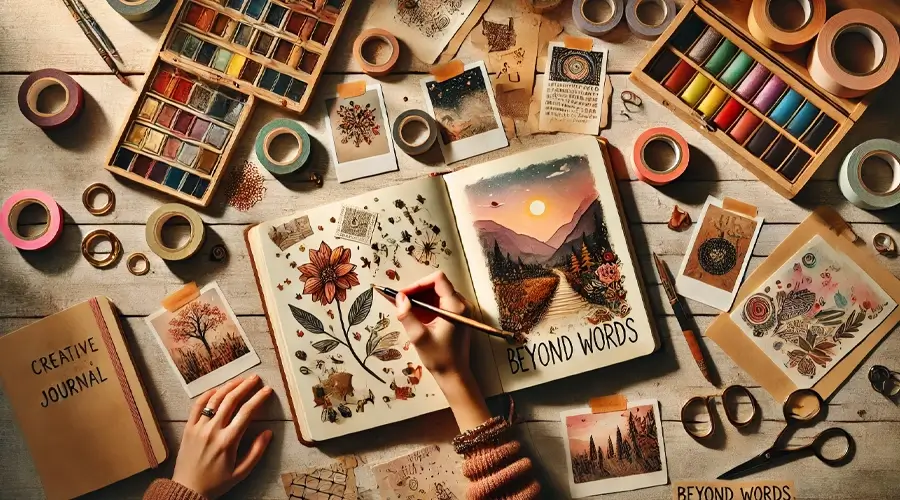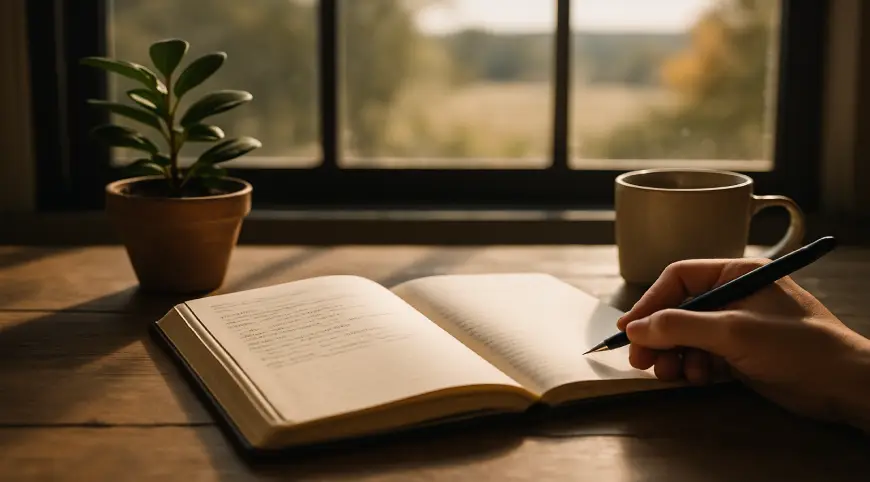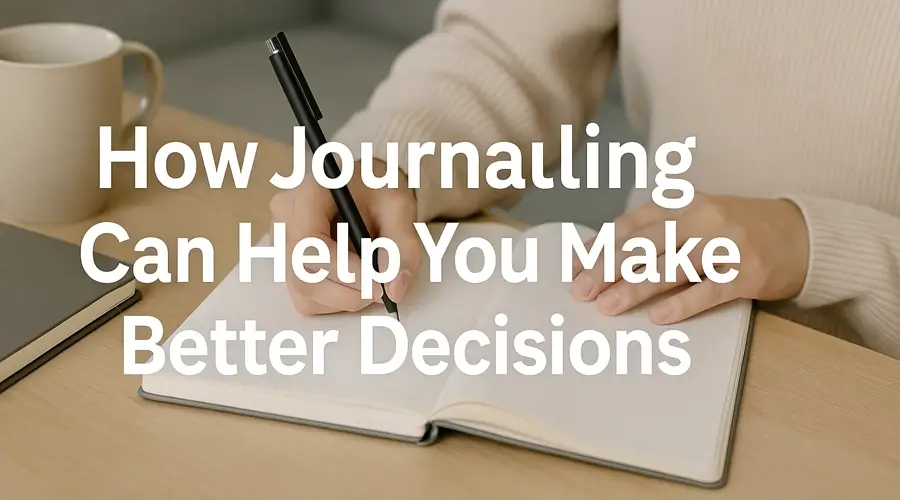For many, journaling has long been synonymous with putting pen to paper, documenting thoughts, emotions, and daily events in a linear fashion. While this traditional method remains powerful, it doesn’t resonate with everyone—some find words limiting, while others crave a more immersive way to process their experiences. Exploring creative alternatives to journaling can unlock deeper levels of self-expression, making it a more engaging and fulfilling practice. Whether through visuals, movement, sound, or storytelling, non-traditional journaling methods cater to different personality types, allowing individuals to express themselves in ways that feel most natural and meaningful. By stepping beyond words, journaling becomes an art form—one that nurtures mindfulness, emotional clarity, and creativity in unexpected ways.
Visual Journaling: Expressing Through Art
Not all thoughts and emotions can be neatly captured in words. Sometimes, the most profound feelings are best expressed through colors, shapes, and textures. Visual journaling transforms the act of reflection into a creative, artistic experience—one where self-expression is not bound by sentences but unfolds through sketches, doodles, paintings, and mixed media.

Sketching, Doodling, and Painting as an Emotional Release
Drawing can be an instinctive and liberating way to journal, especially for those who struggle to articulate emotions through words. A simple doodle can capture the essence of a mood, while abstract painting can serve as a therapeutic outlet for stress or joy. Even quick sketches of daily life can become a visual diary, allowing for a more intuitive and immediate way to document experiences. Unlike written journaling, which often requires structured thought, visual journaling allows emotions to flow freely onto the page without the pressure of finding the “right” words.
Bullet Journals with Visual Elements for Organizing Thoughts Creatively
Bullet journaling (or BuJo) combines structure with creativity, offering a blend of productivity and self-expression. Instead of traditional diary-style entries, a bullet journal uses symbols, lists, and trackers, often enhanced with hand-drawn elements, watercolor backgrounds, or themed layouts. This approach transforms planning and reflection into a visually appealing and engaging experience. Whether it’s designing mood trackers, habit logs, or goal-setting pages, bullet journaling makes self-organization feel less like a task and more like an artistic ritual.
Collage Journaling: Using Images and Textures to Tell a Story
Sometimes, words fall short, but a carefully chosen image can say everything. Collage journaling is a tactile and immersive way to document emotions, dreams, and experiences. By cutting out images from magazines, printing photographs, or incorporating textures like fabric or pressed flowers, a collage journal becomes a rich, multi-dimensional reflection of personal thoughts. This method is especially powerful for vision boards, storytelling, or processing emotions through curated visuals. The act of arranging and layering materials can also be meditative, making it an excellent tool for mindfulness.
Visual journaling is a deeply personal and freeing experience, offering an alternative to traditional writing-based journaling. Whether through a paintbrush, a pen, or a pair of scissors, the creative possibilities are endless. The key is to let go of perfection and allow the process itself to become a form of self-discovery.
Audio and Video Journaling: Capturing Real Emotions
While traditional journaling relies on the written word, audio and video-based methods offer a dynamic way to document thoughts, emotions, and experiences. These formats preserve tone, inflection, and raw emotion—elements often lost in written text. For those who find writing restrictive or want a more immersive way to reflect, audio and video journaling provide an expressive alternative that engages both memory and emotion in a uniquely personal way.
Voice Memos as a Personal Journaling Tool
Recording voice memos is one of the simplest yet most effective ways to engage in journaling without the need for pen and paper. Unlike written journals, where thoughts can be filtered and refined, voice memos capture the spontaneity of emotions in real time. This method allows for unstructured, free-flowing expression—perfect for those who process their thoughts best through speaking rather than writing.
Additionally, voice-based journaling fosters a stronger emotional connection to past experiences. When played back, the tone of voice, pauses, and inflections provide context that written words cannot replicate. This can be particularly powerful for tracking emotional growth, reliving special moments, or even identifying patterns in thought processes over time.
For those with a busy lifestyle, voice journaling is an ideal on-the-go solution. A simple recording on a smartphone while commuting, walking, or winding down at night can serve as an instant reflection tool without requiring dedicated writing time.
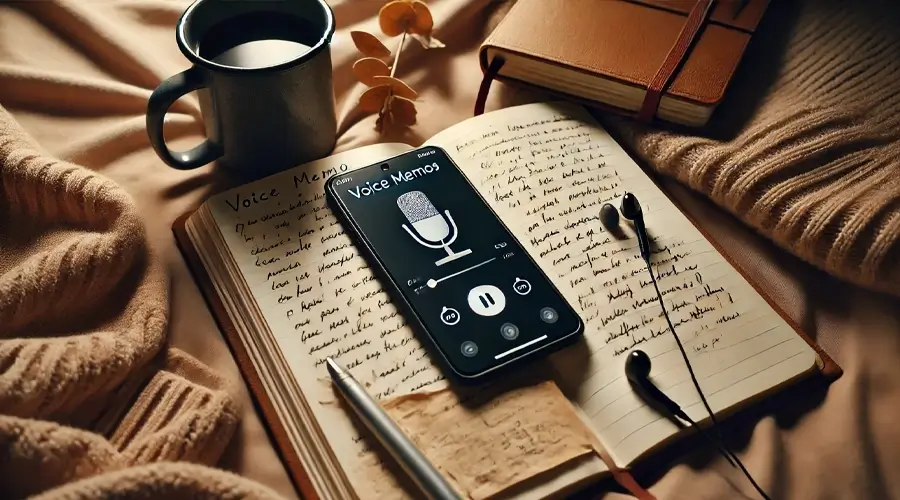
Vlogging: Documenting Daily Life for Self-Reflection (Without the Pressure of Social Media)
In an era where video content dominates social media, the idea of personal vlogging—without sharing it publicly—can be an incredibly powerful self-reflection tool. Video journaling, or vlogging, provides a visual and auditory record of experiences, allowing for a deeper connection to memories. Unlike traditional written journaling, vlogging captures facial expressions, body language, and surroundings, making it a richer, more immersive experience.
For those hesitant about being on camera, this method doesn’t have to be about performance. The goal is authenticity—speaking to yourself as if you were confiding in a trusted friend. This format is particularly effective for tracking personal growth, working through difficult emotions, or documenting creative processes.
An additional advantage of video journaling is its ability to serve as a time capsule. Watching past entries can evoke powerful insights, showing how much one has evolved over time. Unlike social media vlogging, where content is often curated and filtered, private video journaling allows for full vulnerability without external judgment.
Sound Journaling: Associating Sounds and Music with Emotions
Sound is a profound emotional trigger—certain songs, ambient noises, or even everyday sounds can instantly transport us to specific moments or moods. Sound journaling leverages this connection by using audio cues to document emotions and experiences.
There are several ways to engage in sound-based journaling:
- Creating personalized soundtracks – Selecting or composing music that reflects current emotions, much like a musical diary.
- Recording ambient sounds – Capturing everyday moments, like the sound of rain, city streets, or nature, to associate with different moods.
- Using music as memory anchors – Associating specific songs with key experiences or journaling sessions to recall emotions vividly when replayed.
This method is particularly effective for individuals who connect deeply with music or find that words alone fail to encapsulate their emotions. By curating a personal “sound diary,” one can revisit memories not just through thoughts, but through immersive auditory experiences.
Audio and video journaling redefine self-expression, offering depth and nuance beyond written words. Whether through spontaneous voice recordings, private video reflections, or sensory-rich soundscapes, these methods provide a profound way to document life authentically. The key is to embrace the format that resonates most, allowing emotions to flow naturally and creating a journaling experience that feels effortless yet deeply meaningful.
Movement-Based Journaling: Mind and Body Connection
For many, journaling is a stationary activity—sitting down with a notebook or a device to capture thoughts. But what if self-reflection didn’t require stillness? Movement-based journaling taps into the powerful connection between body and mind, allowing emotions to flow in sync with physical activity. By integrating movement, journaling becomes a dynamic process that encourages deeper self-awareness, reduces stress, and unlocks creativity in ways traditional methods often cannot.

Dance and Movement as a Form of Self-Expression
Not all thoughts need to be written down to be processed. Dance, gestures, and freeform movement can act as a physical diary, allowing emotions to manifest through the body. Whether it’s a structured dance routine or spontaneous movement to music, the act of expressing feelings physically can be incredibly liberating.
For some, movement-based journaling might involve recording short videos of dance sessions that reflect a particular mood, while others may prefer to move intuitively without documentation. The key is to focus on how movement feels rather than how it looks. This practice can be especially helpful for processing emotions that feel too complex or overwhelming to articulate in words. Letting the body lead can uncover subconscious feelings and provide clarity without the pressure of verbal expression.
Yoga or Mindful Stretching While Mentally Processing Thoughts
Yoga and gentle stretching can turn journaling into a meditative experience. Instead of writing, individuals can use intentional movement to reflect on thoughts, set intentions, or process emotions. This method combines the grounding effects of movement with the introspection of journaling, helping to quiet mental noise while fostering a deeper connection with oneself.
For example, starting a yoga session with a question—such as What do I need to let go of today?—can create space for intuitive answers to arise through breath and motion. Similarly, focusing on specific themes (such as gratitude, forgiveness, or creativity) during a stretching routine can guide self-reflection without needing to put pen to paper.
To enhance the practice, some may choose to record voice memos or jot down key insights after their session. However, the true value lies in using the body as a conduit for processing thoughts, rather than feeling obligated to document everything.
Walking Journaling: Recording Thoughts On-the-Go
Walking is one of the simplest yet most effective ways to engage in movement-based journaling. The rhythmic motion of walking has been shown to stimulate creativity, improve mood, and enhance cognitive function, making it an ideal activity for reflecting on thoughts and emotions.
There are several ways to incorporate journaling into a walk:
- Voice journaling – Recording thoughts through a voice memo while walking allows for a free-flowing, conversational approach to self-reflection.
- Observational journaling – Taking mental or written notes about surroundings, emotions, and spontaneous insights that arise during the walk.
- Mindful walking – Focusing on each step, breath, and sensation as a way to stay present while processing thoughts internally.
Walking journaling is particularly beneficial for those who struggle to sit still while reflecting or find that movement enhances their ability to think clearly. It also provides a refreshing change of environment, which can lead to new perspectives and creative breakthroughs.
Movement-based journaling invites the body to be part of the self-reflection process, making journaling more intuitive, expressive, and engaging. Whether through dance, yoga, or walking, integrating movement into journaling allows emotions to be processed in a way that feels natural and liberating. By shifting away from the idea that journaling must be a written exercise, individuals can discover new ways to connect with themselves—both mentally and physically.
Storytelling Journaling: Fictionalizing Your Thoughts
Sometimes, reality feels too raw, too direct, or too overwhelming to put into words. That’s where storytelling journaling comes in—a creative way to process emotions, memories, and thoughts by transforming them into fictional narratives. This approach allows for self-expression without the constraints of literal truth, making it easier to explore deep emotions, unresolved experiences, and future aspirations in a safe and imaginative way. By stepping into the role of a storyteller, journaling becomes not just a form of reflection, but also a creative exercise that can lead to surprising insights and emotional breakthroughs.
Writing Fictional Letters to Future or Past Selves
One of the most powerful ways to engage in storytelling journaling is by writing letters—either to a past version of yourself, a future self, or even an alternative version of who you are today. These letters create a bridge between different stages of life, helping you process past regrets, express gratitude, or set intentions for the future.
For example, writing to your younger self might offer words of comfort, wisdom, or encouragement that you wish you had received at a crucial moment. A letter to your future self can serve as a time capsule, capturing current thoughts, dreams, and fears that will one day be reflected upon with new perspective. Some people even take this practice further by scheduling these letters to be opened years later, creating a deeply personal dialogue across time.
Creating Characters to Process Real-Life Emotions Indirectly
Not everyone feels comfortable addressing personal emotions head-on. Sometimes, it’s easier to process pain, joy, or uncertainty through the lens of a fictional character. This technique involves creating a character who embodies certain emotions or experiences and allowing them to navigate situations similar to your own.
For example, if you’re struggling with a difficult decision, you might write about a protagonist facing the same crossroads—how do they handle it? What choices do they make? Seeing your struggles played out in a fictional setting can provide clarity, emotional distance, and even solutions you hadn’t considered before.
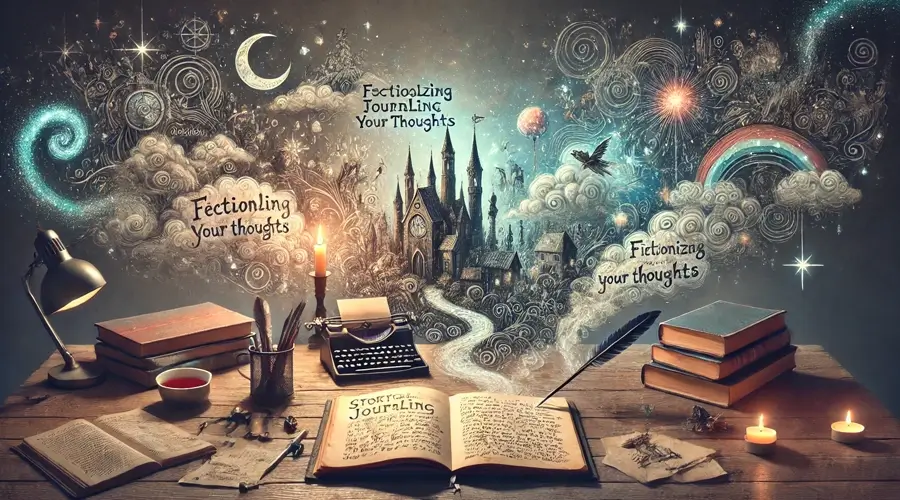
Additionally, crafting characters can serve as a form of self-discovery. Often, the traits we give them—whether strengths or vulnerabilities—reflect aspects of ourselves that we may not have fully acknowledged. Through storytelling, we uncover hidden fears, suppressed desires, and personal growth opportunities in ways that feel less intimidating than traditional self-reflection.
Microfiction Journaling: Telling Short, Emotional Stories Instead of Diary Entries
For those who enjoy creative writing, microfiction journaling is an exciting alternative to traditional diary entries. Instead of writing about daily events in a straightforward way, this approach encourages you to capture emotions, experiences, or thoughts in the form of very short, evocative stories.
A microfiction journal entry might be a scene between two strangers that mirrors an internal conflict you’re facing. It could be a one-paragraph story that captures the mood of a particular day without explicitly stating what happened. By turning real emotions into small, vivid narratives, this method makes journaling feel more artistic and expressive, rather than just a routine documentation of life.
Microfiction journaling also removes the pressure of writing lengthy, detailed entries. A few sentences or a single paragraph can be enough to capture a powerful moment. Over time, reviewing these short stories can reveal patterns in emotions, thoughts, and personal growth, much like a traditional journal—but with an added layer of creativity.
Storytelling journaling offers a refreshing way to reflect on life while embracing creativity. Whether through fictional letters, character-driven narratives, or microfiction, this method allows for deep self-expression without the limitations of literal truth. By stepping into the role of a storyteller, you gain a new perspective on emotions, making the journaling process both therapeutic and imaginative.
conclusion
In this article, we explored how journaling doesn’t have to be confined to words on a page. Traditional writing works for some, but for those who crave a more immersive, expressive, or unconventional approach, alternative journaling methods open up new creative pathways.
From visual journaling, where sketches and collages replace written reflections, to audio and video journaling, which capture raw emotions in real-time, self-expression can take many forms. We also looked at movement-based journaling, where thoughts flow freely through dance, yoga, or walking, and how storytelling journaling allows emotions to be fictionalized through characters, micro-stories, or letters to different versions of ourselves.
The beauty of journaling is that it is deeply personal—there are no rules, only possibilities. Whether you prefer a pen, a paintbrush, a voice memo, or a camera lens, the goal is the same: to connect with your inner self in a way that feels authentic and fulfilling. By stepping beyond words, journaling becomes more than just a habit—it becomes an art form, a sanctuary, and a tool for self-discovery.
Start your journey to self-discovery — download the Verbo AI Journaling App today!
Capture your thoughts, track your growth, and reflect anytime, anywhere.
